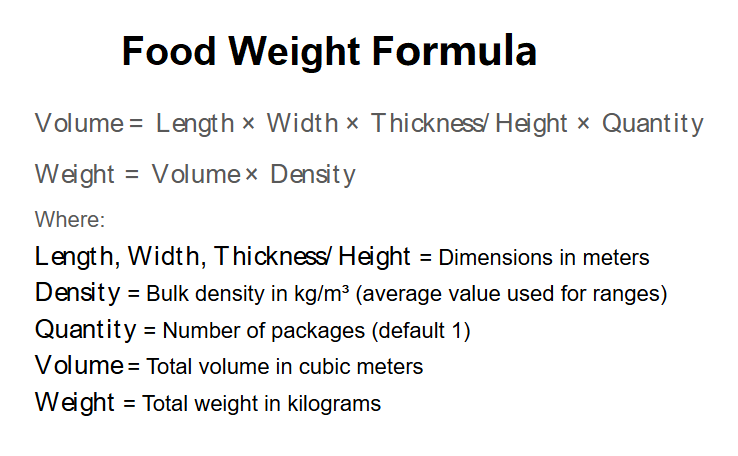 Home
Home
 Back
Back

Food weight is the total mass of a food material, calculated based on its dimensions, bulk density, and packaging quantity. Food volume is the total space occupied by the food, calculated from its dimensions and quantity. These metrics are crucial for storage, transportation, and recipe planning in food industries.
For example, a 1 m × 0.5 m × 0.2 m package of Wheat (density 770 kg/m³) with a quantity of 1 has a volume of 0.1 m³ and weighs approximately 77 kg.
Formulas:
\(\text{Volume} = \text{Length} \times \text{Width} \times \text{Thickness/Height} \times \text{Quantity}\)
\(\text{Weight} = \text{Volume} \times \text{Density}\)
Where:
Example Calculation: For a package of Wheat:
Use the form above to input dimensions, select a food type, and specify quantity to calculate the food volume and weight.
The following table lists common food materials and their bulk densities (in kg/m³), with averages used for ranges:
| Food Material | Bulk Density (kg/m³) |
|---|---|
| Barley | 600 |
| Beans | 700 |
| Beets, whole | 760 |
| Brewers grain, spent dry | 450 |
| Butter | 911 |
| Wheat | 770 |
(Note: Full list included in the dropdown; table truncated for brevity.)
The calculator displays results in the following units:
Results are provided in all listed units after calculation.
How do you calculate food weight and volume?
To calculate food weight and volume:
What is the volume and weight of a 1 m × 0.5 m × 0.2 m package of Honey?
For Honey (density 1420 kg/m³), quantity 1: